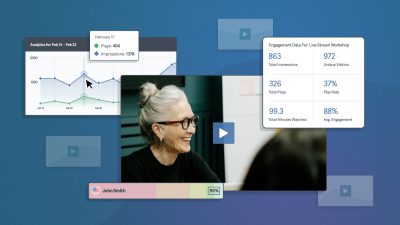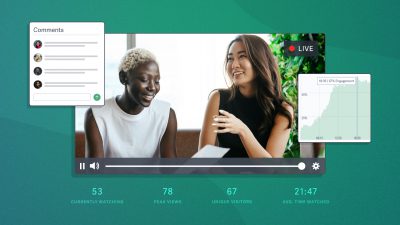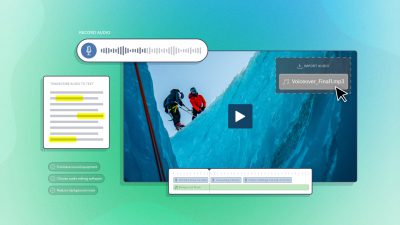Getting started with corporate video can feel really intimidating. Sets, equipment, scripting – there are a lot of moving parts. It can be hard to know where to begin.
We’re here to tell you that it’s actually not that bad. In fact, you can film plenty of video from where you’re sitting right now – at the office.
We’ve gathered the top seven types of corporate video perfect for filming in an office setting. We also included an overview of the gear you’ll need to produce it. Keep reading to get inspired, and start cranking out video!
1. Interview a Thought Leader
It doesn’t matter which industry you’re in. Chances are, you’re connected to a thought leader of interest to your target customers. As an added bonus, these types of videos are also great for employee education.
The best part? Thanks to video, you don’t even have to be in the same room as your chosen expert.
The Concept
Reach out to a few people with unique perspectives on the topic you’d like to address. Then, setup a video call with each individual so you can ask their opinion on current events, or other issues pertinent to your customers.
The goal is to get them talking, not to get a scripted performance. Write down a few prompts to help the conversation along, and do some general research into their area of expertise to lend depth to your own contributions.
If possible, mix up the camera angle by setting up a separate camera that films you at your desk while the call is happening. Especially when you’re speaking, it’s a great way to change up the camera angle, or cover any edits. If you need extra tips, read this post on nailing video interviews.
2. Weekly, Monthly, or Quarterly Updates
So much can happen on the daily grind that it’s easy for teams to fall out of sync. Start recapping your progress on video, and share it with other members of your organization.
The Concept
This video is much more scripted, but should still be full of personality. It’s your chance to showcase your accomplishments, and plans for next steps.
If you’re part of a team, be sure to include them in the video. That way they can have a chance to share their perspectives as well. A mix of voices will help keep it lively and engaging.
Remember, with corporate video, it’s all about showing rather than telling. Use a screen capture program to record clips of any relevant updates to your website. You can also mix in stock footage if needed. Another option is to convert a presentation to video, using a voiceover where appropriate.
If you use the latter two suggestions, be sure to appear in the video personally, even if it’s just at the beginning or end. The people you’re sharing it with will want to know who’s behind the video, and this will help put a face to the name.
Above all, be sure to share this type of corporate video securely.
3. Instructional Videos
Whether it’s a common customer question, or a cool product hack you recently learned, sharing it via video can really help get the word out. This type of corporate video seeks to inform and educate the viewer about an unfamiliar topic, product, or concept.
The Concept
Determine the question you want to address. Keep it very specific and narrow. This focus will help ensure viewers get what they came for, and leave confident they learned something new.
Whether you appear in the video, or rely on screen captures and stock footage is entirely up to you. It really depends on the topic you’re addressing.
Try to stick to a minute or two at the most. Any longer, and you’ll likely lose your audience’s interest. Or, it could mean the topic is too broad.
A moderate pace, clear visuals, and a recap at the end are all key to getting instructional videos right. These learning tools will help your viewers absorb the information, and remember it down the road.
You might publish this video in the help section of your website, include it in a blog post, or send it to interested parties directly via email. After all, educational videos can be highly effective marketing tools.
4. Recruiting Videos
With any exceptionally qualified candidate, your job is to convince them they want to work at your company just as much as it’s their job to convince you to hire them. That’s where recruiting videos can help.
The Concept
Most due diligence about prospective employers happens online. If a candidate is researching your company, a video can help them understand your brand, and what it’s like to work for you. The goal is to make it clear they’d be silly not to take the job in a light-hearted and fun way.
Loop in other members of your team to get candid takes on what it’s like to be a part of the team. Write out a few questions in advance that might invite compelling answers. For instance:
- What’s your favorite part of the day?
- What was the main reason you decided to join this company?
- What do you really like about working here?
- Which project are you most proud of to date?
- How would you describe the company culture?
Then, take some simple shots of people going about their business in the office. Think making coffee, having a meeting, or talking on the phone. Capturing the day-to-day helps prospective candidates imagine themselves as a part of the team. Use this footage as b-roll to keep this corporate video visually interesting.
For instance, this video from NewsCred, a content marketing company, gives a really clear picture of what it’s like to work there. It also appears to have been filmed almost exclusively in their offices:
5. Holiday Videos
Giving thanks, getting in the spirit, sharing the joy – who doesn’t love a great holiday video? While most most corporate videos tend to steer clear of speaking to any specific denomination, this is still a great chance to tap into consumer excitement around major holidays.
The Concept
You can go pretty nuts with a holiday video. It’s the perfect opportunity to think outside the box, and do something big. If you’ve ever wanted to try coordinated dancing, lip-syncing, practical jokes, or funny costumes, now’s your chance.
If that feels too ambitious, a simple heartfelt “thank you” video will do the trick. Props are still your friend, even if it’s just some handheld signs.
In either case, you’ll want to plan this one ahead of time. Be sure to loop in other team members to help coordinate the video. Script it out carefully, and do a few run throughs until everyone feels comfortable with the game plan.
For some more inspiration, check out this guide to making a holiday video people will actually watch.
6. Message From the CEO
Say your company just hit a major milestone. Maybe there’s a product release on the horizon. Whenever something big is happening, corporate video is a great way to get the word out across an organization.
The Concept
Snag a few moments to catch some soundbites from your CEO reflecting on the recent happenings. This should be a short and sweet communiqué that quickly gets to the heart of the issue. Provide just enough context so that no one gets lost.
If this is a simple video that only shows your CEO speaking, consider using at least two camera angles to record the footage. That way, you can switch between perspectives to cover edits, or just vary the visuals a little bit.
Lacking inspiration for your CEO’s message? Check out this blog post with fifteen ideas for getting corporate video communications right.
7. Behind-the-Scenes
Planning an event? Hosting a conference? Just another busy day at the office? Great! All of those are excellent opportunities to provide a behind-the-scenes peek at goings-on at your organization for your next corporate video.
The Concept
You might make a video containing only behind-the-scenes footage. Or, you might just use it as supplemental footage in future videos.
Either way, the idea is to capture the atmosphere rather than follow a specific script. Join the fray with a videocamera in hand, and try to get special moments on film.
Naturally, if you’re aiming to capture a regular day in the office, communicate the general concept ahead of schedule. You don’t want to startle your coworkers with a camera on a Monday.
This is also a great opportunity to get candid soundbites on film. Pull colleagues aside, and ask them a quick question that only requires a short answer. Avoid putting them on the spot by picking a fun and easy topic.
A video like this could be shared as a sort of blooper reel with colleagues after an event. Or, you could work it into another video project if it’s appropriate. Sometimes, these types of videos make for excellent marketing material for future events.
Equipment Required
Since you’re filming in a controlled environment, your needs are relatively straightforward. However, there are some special considerations for filming in an office environment.
The Basics
All you really need is a camera, a computer, a way to capture sound, and an internet connection to get started.
If you’re performing interviews, or working with remote team members, you’ll also need a platform to conduct video calls online. There are plenty of free or paid options out there, such as Skype, GoToMeeting, or Google Hangouts for starters.
Some video conference platforms have recording features built-in. If so, great. Taking advantage of those features will likely be the easiest way to capture a video call.
If not, don’t fret. You can use screen recording software, like Snagit or ScreenFlow, to capture the video call as it unfolds.
Lighting
Many offices have fluorescent overhead lighting, which totally washes people out on camera. Overhead lighting also usually creates harsh shadows on subject’s faces.
You can overcome these challenges by finding a corner of your office with natural light. It will help warm up natural skin tones, and, depending on the angle of the sun, won’t create harsh shadows.
Alternatively, acquire some inexpensive floor lamps, or borrow some desk lamps. Chances are, the bulbs will be a warmer color temperature. You’ll also be able to direct the lighting at your subject instead of dealing with strictly overhead lighting sources.
For more ideas on overcoming in-office lighting challenges, check out this guide to quick and simple lighting.
Sound
Sometimes, the hubbub of an office is a desired background sound effect. Other times, it’s not. Noisy coffeemakers, phones, conversations, loud HVAC systems, the clacking of printers and more can all interfere significantly with your sound on camera.
Try to book a conference room, or find an office with closed doors, when it’s time to film. This will help prevent unwanted noises from ruining your audio.
Even in a quiet room, audio can still be a concern, especially with built-in microphones. You might be too muted, or the sound can just be flat.
An easy workaround is to record your end of the conversation with a different recording device, such as a smartphone. If possible, a lapel or shotgun microphone might also be worth acquiring for your shoot. The right choice depends on the type of video you’re filming, and the camera you’re working with. There are even great options for smartphones these days.
Lapel mics are great for capturing just one person speaking up close. They are usually clipped directly onto the subject’s shirt. Wireless lapel mics are a great option, especially if you’re unsure of the distance at which you might be recording.
Shotgun mics are a little more versatile. Mounted on the camera, a rig, a stand, or a boom, shotgun mics mainly pick up sounds from the direction in which they are pointed.
Summary of Equipment Needed
No matter which pieces of equipment you’re working with, be sure to familiarize yourself with all of it well in advance. You don’t want to be fumbling with the controls once the shoot is underway.
- Webcam, smartphone, DSLR, or videocamera – whatever you are most comfortable with is likely the best choice
- Natural light, or alternative “warm” lighting sources
- Microphone
- Video call service
- GoToMeeting, Skype, Google Hangouts, etc
- Screen recording program
- Snagit, Screenflow, etc
- Video editing program
- iMovie, Windows Moviemaker, FinalCut, Adobe Premiere, etc
If you need a secure way to share your corporate video, SproutVideo can help with that. Check out our security features, and signup for a free trial if you’d like to check them out!








